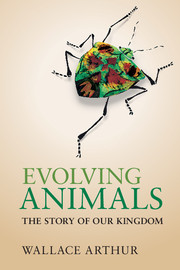Book contents
- Frontmatter
- Dedication
- Contents
- Preface
- Acknowledgements
- 1 What is an animal?
- 2 Before there were animals
- 3 How to make a fossil
- 4 The Cambrian explosion
- 5 How to make a species
- 6 Jellyfish and their kin
- 7 How to make a tree
- 8 The enigmatic urbilaterian
- 9 Animal symmetry and heads
- 10 A plethora of worms
- 11 Trends in animal complexity
- 12 Where the octopus is king
- 13 How to make an animal
- 14 Exoskeletons galore
- 15 Extinction
- 16 Mouth first, mouth second
- 17 Comparing embryos
- 18 Larvae, mouthparts and moulting
- 19 The animal toolkit
- 20 Vertebrate origins and evolution
- 21 From water to land to water
- 22 Variation and inheritance
- 23 Evolutionary novelties
- 24 Human origins and evolution
- 25 Animal plasticity
- 26 The nature of adaptation
- 27 The direction of evolution
- 28 Animal extremophiles
- 29 Extraterrestrial animals?
- 30 The ghost in the machine
- Appendix
- References
- Index
14 - Exoskeletons galore
Published online by Cambridge University Press: 05 August 2014
- Frontmatter
- Dedication
- Contents
- Preface
- Acknowledgements
- 1 What is an animal?
- 2 Before there were animals
- 3 How to make a fossil
- 4 The Cambrian explosion
- 5 How to make a species
- 6 Jellyfish and their kin
- 7 How to make a tree
- 8 The enigmatic urbilaterian
- 9 Animal symmetry and heads
- 10 A plethora of worms
- 11 Trends in animal complexity
- 12 Where the octopus is king
- 13 How to make an animal
- 14 Exoskeletons galore
- 15 Extinction
- 16 Mouth first, mouth second
- 17 Comparing embryos
- 18 Larvae, mouthparts and moulting
- 19 The animal toolkit
- 20 Vertebrate origins and evolution
- 21 From water to land to water
- 22 Variation and inheritance
- 23 Evolutionary novelties
- 24 Human origins and evolution
- 25 Animal plasticity
- 26 The nature of adaptation
- 27 The direction of evolution
- 28 Animal extremophiles
- 29 Extraterrestrial animals?
- 30 The ghost in the machine
- Appendix
- References
- Index
Summary
In this chapter, we examine the nature of those animals that collectively form the biggest group in the animal kingdom – Arthropoda – and explore their evolutionary relationships, both with each other and with other animals. The Arthropoda is the most species-rich phylum by a very long way. There are well over a million species of arthropods (most of them insects); this means that they make up more than three-quarters of the known animal kingdom. Arthropod species inhabit almost all environments on Earth, from the deepest oceans to the driest deserts.
The key feature underlying the success of the arthropods is the exoskeleton. In fact, a hard structure acting as, among other things, an anchor-point for muscles, is a key feature in the second- and third-largest groups of animals too. Most molluscs have a shell, or a pair or series of them, as we noted in Chapter 12; and species of our own group, the vertebrates, are characterized by possession of endoskeletons. Not only do all these hard structures provide a key part of a crucial biomechanical system that allows movement, but they also allow more frequent fossilization than do soft tissues.
- Type
- Chapter
- Information
- Evolving AnimalsThe Story of our Kingdom, pp. 135 - 145Publisher: Cambridge University PressPrint publication year: 2014



